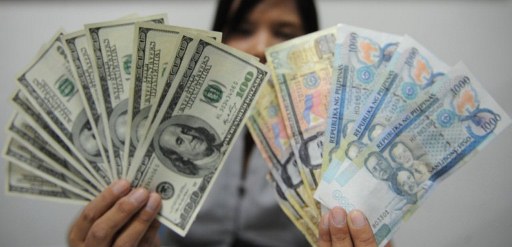MANILA — After trading within the 50:$1 level for almost two months, the peso on Monday strengthened against the US dollar to close at 49.705:$1.
The peso hit an intraday high of 49.7:$1 and a low of 49.88:$1 after opening at 49.88:$1.
Monday’s close was stronger than last Friday’s 50.08:$1. The peso had slid to the 50:$1 level, the weakest in over a decade, since Feb. 17.
The total volume traded more than doubled to $1.12 billion from $504.5 million last Friday.
“Our traders receive report that the market seems to be encouraged by the good prospects of the government’s tax reform package and tax amnesty plan. As you know, we have expressed support of such a plan because from a monetary perspective, over the medium term, that is going to be a positive for price stability,” Bangko Sentral ng Pilipinas Deputy Governor Diwa C. Guinigundo said in a text message to reporters, referring to Finance Secretary Carlos G. Dominguez III’s pronouncement last week that the government was eyeing massive tax amnesty akin to that implemented in neighboring Indonesia.
The Duterte administration’s proposed comprehensive tax reform program is aimed at funding public infrastructure buildup, which entails trillions in pesos in investments, through additional taxes on consumption, while also easing the burden on personal and corporate income taxpayers.
“Infrastructure spending is a winning proposition for everyone. I also believe that the country’s sustained positive macroeconomic outlook on growth and price stability helped convince the market that it needed to consolidate and reconsider its unfavorable view about the peso. Despite some political noise, the economy is well on its track of demonstrating its good performance despite the risky operating environment,” Guinigundo said.
The peso was the worst performing currency in the region during the first quarter, as it depreciated by an average of 0.88 percent whereas other currencies strengthened against the US dollar.
For Land Bank of the Philippines market economist Guian Angelo S. Dumalagan, “the peso’s appreciation might be attributed to profit taking ahead of the long weekend.”
“It might also be a reflection of foreign investors renewed interest in the Philippines, as evidenced by the surge in local stocks in the past few days,” Dumalagan added.
However, Dumalagan said that he deemed “the peso’s recent strength might be short-lived considering that the US is still generally on track to hiking rates two more times this year.”
“Expectations of more US fiscal stimulus might also lead to a generally weaker peso this year,” according to Dumalagan. SFM
